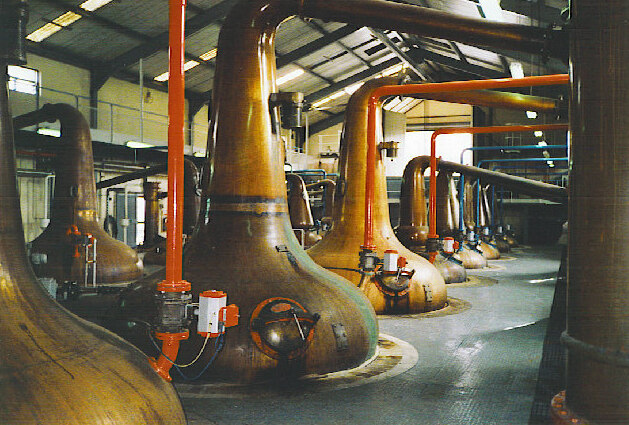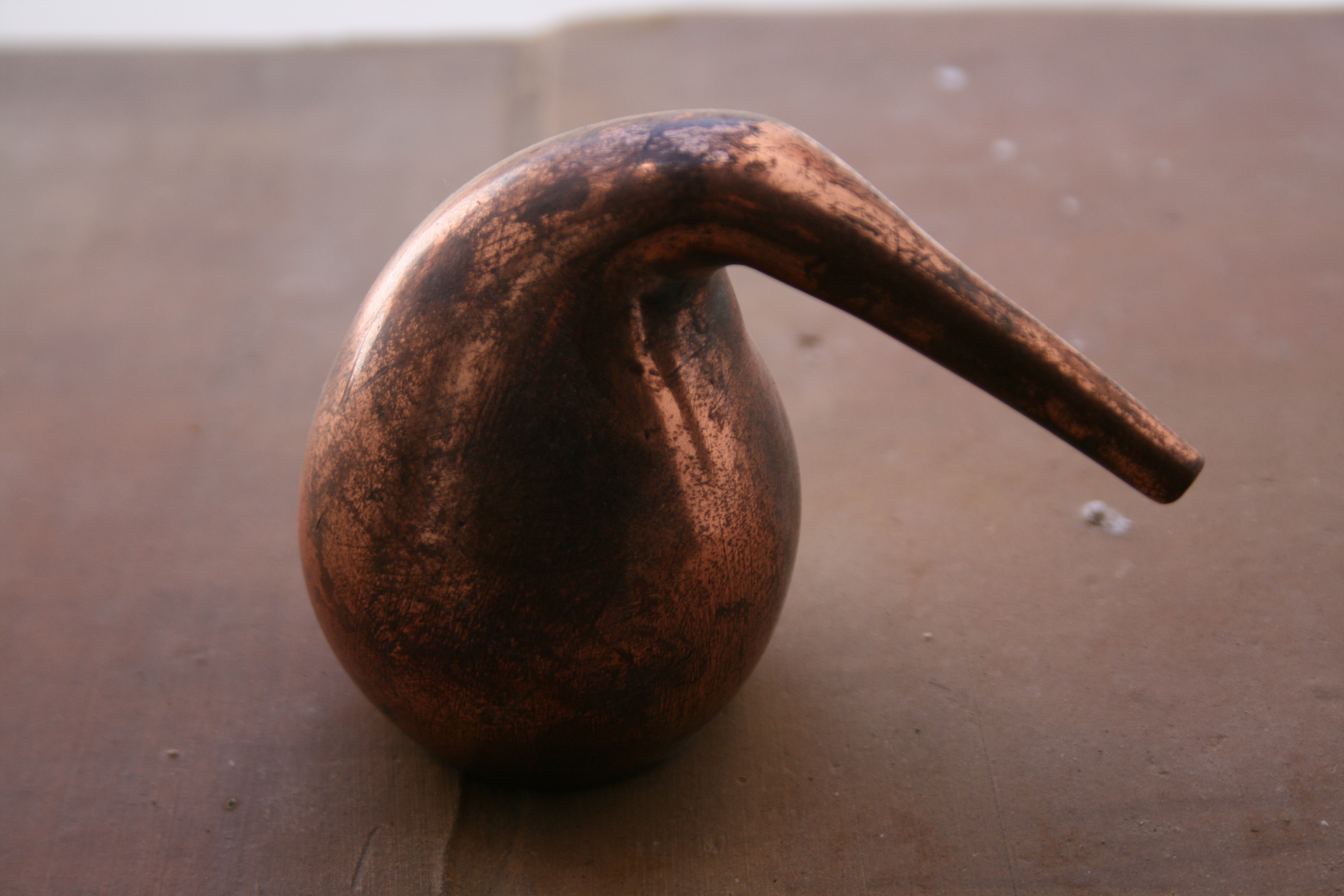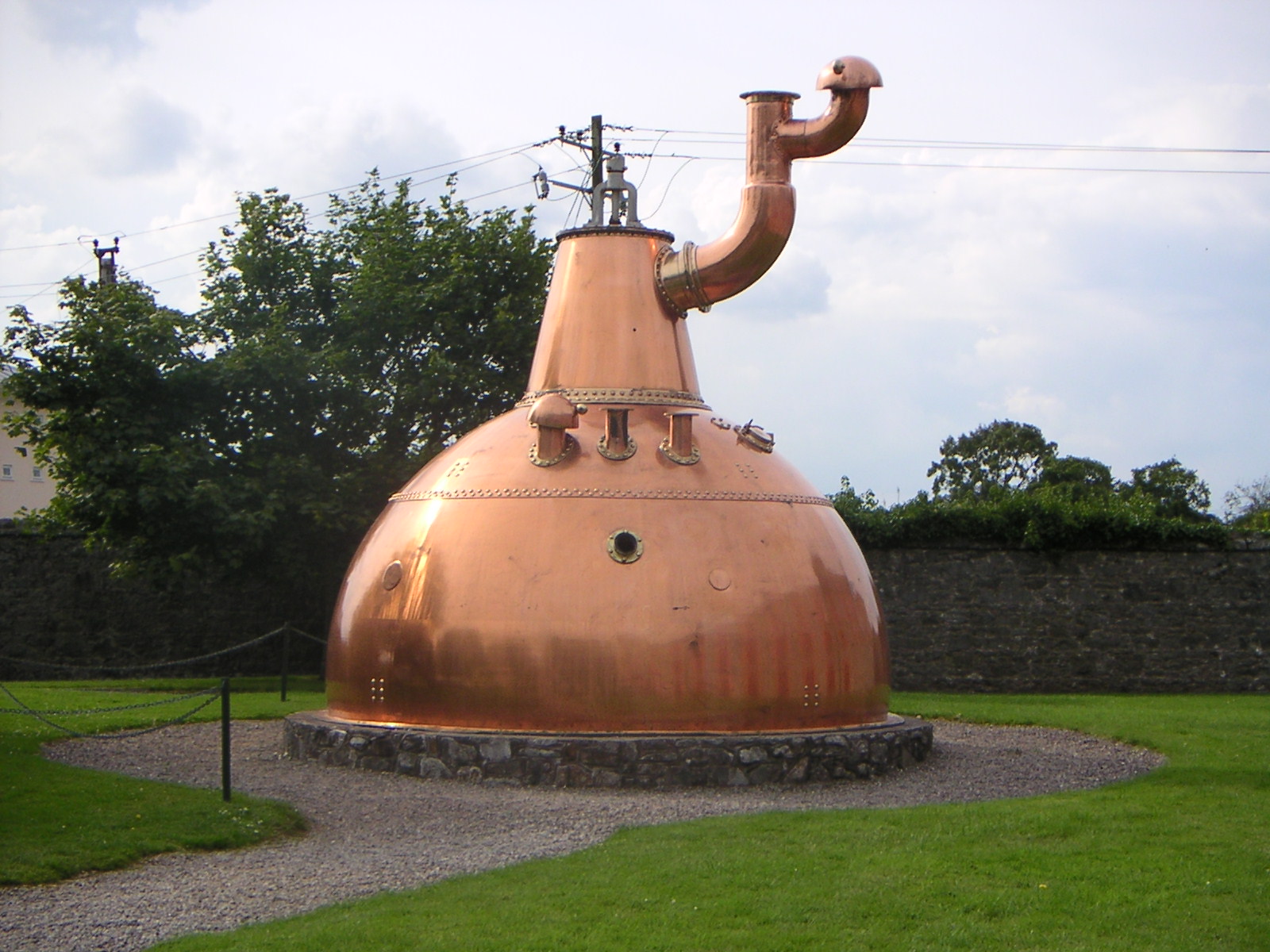|
Alembic
An alembic (from ar, الإنبيق, al-inbīq, originating from grc, ἄμβιξ, ambix, 'cup, beaker') is an alchemical still consisting of two vessels connected by a tube, used for distillation of liquids. Description The complete distilling apparatus consists of three parts: the "cucurbit" (Arabic: ; Greek: , ), the still pot containing the liquid to be distilled, which is heated by a flame; the "head" or "cap" (, ; Greek , ) which fits over the mouth of the cucurbit to receive the vapors, with an attached downward-sloping "tube" (, ); and the "receiver" (, ; , or , ) container. In the case of another distilling vessel, the retort, the "cap" and the "cucurbit" have been combined to form a single vessel. The anbik is also called the raʾs (head) of the cucurbit. The liquid in the cucurbit is heated or boiled; the vapour rises into the anbik, where it cools by contact with the walls and condenses, running down the spout into the receiver. A modern descendant of the al ... [...More Info...] [...Related Items...] OR: [Wikipedia] [Google] [Baidu] |
Alembics From Andreas Libavius Alchymia
An alembic (from ar, الإنبيق, al-inbīq, originating from grc, ἄμβιξ, ambix, 'cup, beaker') is an alchemical still consisting of two vessels connected by a tube, used for distillation of liquids. Description The complete distilling apparatus consists of three parts: the "cucurbit" (Arabic: ; Greek: , ), the still pot containing the liquid to be distilled, which is heated by a flame; the "head" or "cap" (, ; Greek , ) which fits over the mouth of the cucurbit to receive the vapors, with an attached downward-sloping "tube" (, ); and the "receiver" (, ; , or , ) container. In the case of another distilling vessel, the retort, the "cap" and the "cucurbit" have been combined to form a single vessel. The anbik is also called the raʾs (head) of the cucurbit. The liquid in the cucurbit is heated or boiled; the vapour rises into the anbik, where it cools by contact with the walls and condenses, running down the spout into the receiver. A modern descendant of the alemb ... [...More Info...] [...Related Items...] OR: [Wikipedia] [Google] [Baidu] |
Aludel
An aludel ( ar, ﺍﻟﻮﺛﻞ from Greek , 'smoky, sooty, burnt-colored') is a subliming pot used in alchemy. The term refers to a range of earthen tubes, or pots without bottoms, fitted one over another, and diminishing as they advance towards the top. The lowest is adapted to a pot, placed in a furnace, wherein the matter to be sublimed is placed. At the top is a head to retain the flowers, or condensation, which ascends. An aludel was used as a condenser in the sublimation process and thus came to signify the end-stages of transformation and the symbol of creation. Also called the Hermetic Vase, the Philosopher's Egg, and the Vase of the Philosophy. Description The contrivance serves to sublimate mercury (zaybak), sulfur, orpiment (zarnīkh) and the like. It is made of glass or clay (fakhkhār) and consists of two tubes (ziḳḳ, actually hoses) fitted together. The mineral is put in the lower tube, the two tubes are fitted together with clay and the whole is put o ... [...More Info...] [...Related Items...] OR: [Wikipedia] [Google] [Baidu] |
Still
A still is an apparatus used to distill liquid mixtures by heating to selectively boil and then cooling to condense the vapor. A still uses the same concepts as a basic distillation apparatus, but on a much larger scale. Stills have been used to produce perfume and medicine, water for injection (WFI) for pharmaceutical use, generally to separate and purify different chemicals, and to produce distilled beverages containing ethanol. Application Since ethanol boils at a much lower temperature than water, simple distillation can separate ethanol from water by applying heat to the mixture. Historically, a copper vessel was used for this purpose, since copper removes undesirable sulfur-based compounds from the alcohol. However, many modern stills are made of stainless steel pipes with copper linings to prevent erosion of the entire vessel and lower copper levels in the waste product (which in large distilleries is processed to become animal feed). Copper is the preferred materia ... [...More Info...] [...Related Items...] OR: [Wikipedia] [Google] [Baidu] |
Distillation
Distillation, or classical distillation, is the process of separating the components or substances from a liquid mixture by using selective boiling and condensation, usually inside an apparatus known as a still. Dry distillation is the heating of solid materials to produce gaseous products (which may condense into liquids or solids); this may involve chemical changes such as destructive distillation or cracking. Distillation may result in essentially complete separation (resulting in nearly pure components), or it may be a partial separation that increases the concentration of selected components; in either case, the process exploits differences in the relative volatility of the mixture's components. In industrial applications, distillation is a unit operation of practically universal importance, but is a physical separation process, not a chemical reaction. An installation used for distillation, especially of distilled beverages, is a distillery. Distillation includes th ... [...More Info...] [...Related Items...] OR: [Wikipedia] [Google] [Baidu] |
Retort
In a chemistry laboratory, a retort is a device used for distillation or dry distillation of substances. It consists of a spherical vessel with a long downward-pointing neck. The liquid to be distilled is placed in the vessel and heated. The neck acts as a condenser, allowing the vapors to condense and flow along the neck to a collection vessel placed underneath. In the chemical industry, a retort is an airtight vessel in which substances are heated for a chemical reaction producing gaseous products to be collected in a collection vessel or for further processing. Such industrial-scale retorts are used in shale oil extraction, the production of charcoal and in the recovery of mercury in gold mining processes and hazardous waste. A process of heating oil shale to produce shale oil, oil shale gas, and spent shale is commonly called retorting. Airtight vessels to apply pressure as well as heat are called autoclaves. In the food industry, pressure cookers are often referre ... [...More Info...] [...Related Items...] OR: [Wikipedia] [Google] [Baidu] |
Pot Still
A pot still is a type of distillation apparatus or still used to distill liquors such as whisky or brandy. In modern (post-1850s) practice, they are not used to produce rectified spirit, because they do not separate congeners from ethanol as effectively as other distillation methods. Pot stills operate on a batch distillation basis (as contrasted with Coffey or column stills, which operate on a continuous basis). Traditionally constructed from copper, pot stills are made in a range of shapes and sizes depending on the quantity and style of spirit desired. Spirits distilled in pot stills top out between 60 and 80 percent alcohol by volume (ABV) after multiple distillations. Because of this relatively low level of ABV concentration, spirits produced by a pot still retain more of the flavour from the wash than distillation practices that reach higher ethanol concentrations. Under European law and various trade agreements, cognac (a protected term for a variety of brandy prod ... [...More Info...] [...Related Items...] OR: [Wikipedia] [Google] [Baidu] |
Cleopatra The Alchemist
Cleopatra the Alchemist (Greek: Κλεοπάτρα; fl. c. 3rd century AD) was a Greek alchemist, author, and philosopher. She experimented with practical alchemy but is also credited as one of the four female alchemists who could produce the Philosopher's stone. Some writers consider her to be the inventor of the alembic, a distillation apparatus. Cleopatra the Alchemist appears to have been active in Alexandria in the 3rd century or 4th century A.D. She is associated with the school of alchemy typified by Mary the Jewess and Comarius. These alchemists used complex apparatus for distillation and sublimation.Taylor, F. Sherwood. “A Survey of Greek Alchemy”. ''The Journal of Hellenic Studies'' 50 (1930): 109–139. Identity and misnomers Cleopatra is a pseudonym for an unknown author or group of authors. She is not the same person as Cleopatra VII. Nonetheless, she is referred to as Cleopatra, Queen of Egypt, in some later works. One example of this can be found in ''Ba ... [...More Info...] [...Related Items...] OR: [Wikipedia] [Google] [Baidu] |
Gdańsk University Of Technology
The Gdańsk University of Technology (Gdańsk Tech, former ''GUT''; pl, Politechnika Gdańska) is a technical university in the Wrzeszcz borough of Gdańsk, and one of the oldest universities in Poland. It has eight faculties and with 41 fields of study and more than 18 thousand undergraduate, as well as about 626 doctoral students. It employs 2768 people, including 1313 academic teachers. Some degree courses and various specialisations are taught in English. Moreover, some of the courses offered by Gdańsk Tech are unique in Poland, for instance ones in Construction Chemistry, Nanotechnology, Geodesy and Cartography, as well as Engineering of Natural Resources. Students have access to specialist laboratories, lecture theatres with multimedia facilities, a library with 1.2 million volumes and various sports facilities. Undergraduates can also join one or more of 60 student science or language societies as well as other organisations. Gdańsk Tech is the first and only Polis ... [...More Info...] [...Related Items...] OR: [Wikipedia] [Google] [Baidu] |
Muhammad Ibn Zakariya Al-Razi
Abū Bakr al-Rāzī (full name: ar, أبو بکر محمد بن زکریاء الرازي, translit=Abū Bakr Muḥammad ibn Zakariyyāʾ al-Rāzī, label=none), () rather than ar, زکریاء, label=none (), as for example in , or in . In modern Persian his name is rendered as fa, ابوبکر محمدبن زکریا رازی, label=none (see ), though instead of fa, زکریا, label=none one may also find fa, زکریای, label=none (see ). , often known as (al-)Razi or by his Latin name Rhazes, also rendered Rhasis, was a Persian physician, philosopher and alchemist who lived during the Islamic Golden Age. He is widely regarded as one of the most important figures in the history of medicine, and also wrote on logic, astronomy and grammar. He is also known for his criticism of religion, especially with regard to the concepts of prophethood and revelation. A comprehensive thinker, al-Razi made fundamental and enduring contributions to various fields, which he recor ... [...More Info...] [...Related Items...] OR: [Wikipedia] [Google] [Baidu] |
Pseudo-Geber
Pseudo-Geber (or "Latin pseudo-Geber") is the presumed author or group of authors responsible for a corpus of pseudepigraphic alchemical writings dating to the late 13th and early 14th centuries. These writings were falsely attributed to Jabir ibn Hayyan (died 816, latinized as Geber), an early alchemist of the Islamic Golden Age. The most important work of the Latin pseudo-Geber corpus is the ("The Height of the Perfection of Mastery"), which was likely written slightly before 1310. Its actual author has been tentatively identified as Paul of Taranto. The work was influential in the domain of alchemy and metallurgy in late medieval Europe. The work contains experimental demonstrations of the corpuscular nature of matter that were still being used by seventeenth-century chemists such as Daniel Sennert, who in turn influenced Robert Boyle. The work is among the first to describe nitric acid, aqua regia, and aqua fortis. The existence of Jabir ibn Hayyan as a historical fig ... [...More Info...] [...Related Items...] OR: [Wikipedia] [Google] [Baidu] |
Pictogram
A pictogram, also called a pictogramme, pictograph, or simply picto, and in computer usage an icon, is a graphic symbol that conveys its meaning through its pictorial resemblance to a physical object. Pictographs are often used in writing and graphic systems in which the characters are to a considerable extent pictorial in appearance. A pictogram may also be used in subjects such as leisure, tourism, and geography. Pictography is a form of writing which uses representational, pictorial drawings, similarly to cuneiform and, to some extent, hieroglyphic writing, which also uses drawings as phonetic letters or determinative rhymes. Some pictograms, such as Hazards pictograms, are elements of formal languages. "Pictograph" has a different definition in the field of prehistoric art (which includes recent art by traditional societies), where it means art painted on rock surfaces. This is in comparison to petroglyphs, where the images are carved or incised. Such images may ... [...More Info...] [...Related Items...] OR: [Wikipedia] [Google] [Baidu] |






